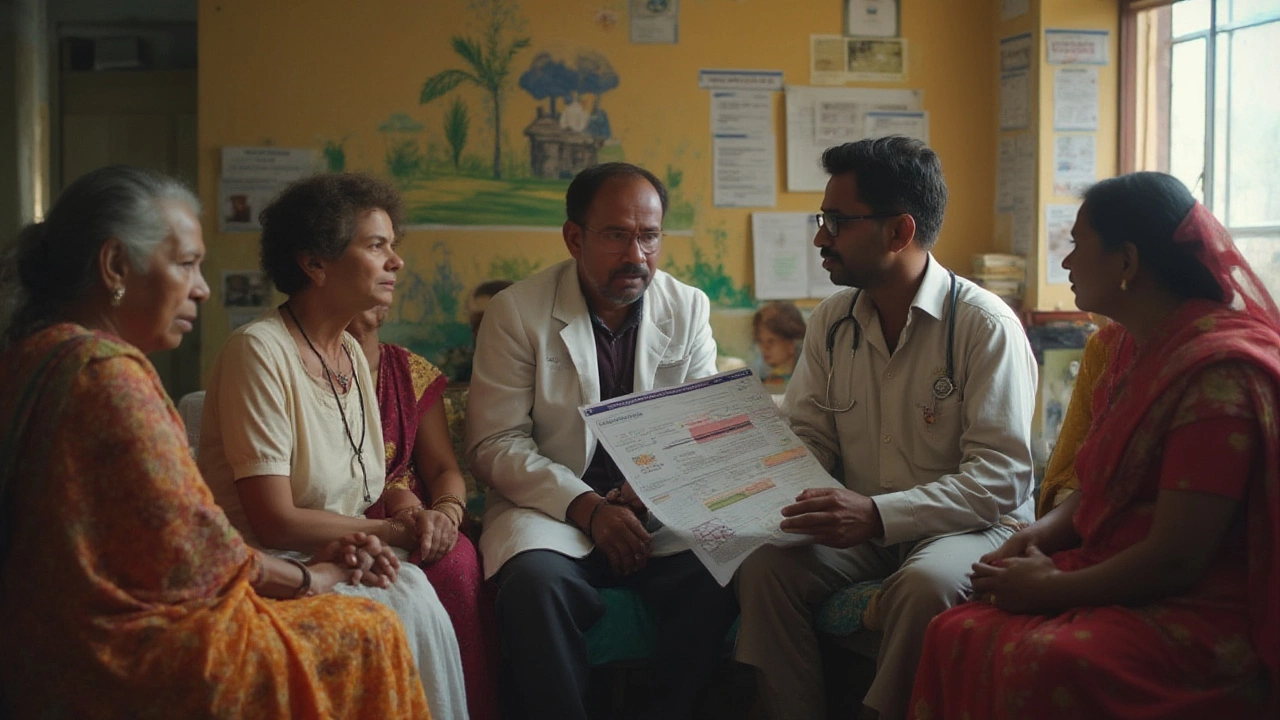There’s a buzz at every diabetes clinic: another new pill for type 2 diabetes just hit the shelves in 2024, shaking up how doctors treat millions. People have spent decades relying on metformin, sulfonylureas, or figuring out complicated insulin injections. Now, a once-daily tablet promises lower blood sugar, easier routines, and even weight loss for some. But do these bold claims stack up? Sure, the ads look tempting, but anyone living with type 2 diabetes knows quick fixes never last—or even work. So, what’s actually different about this newcomer?
Meet the Newest Type 2 Diabetes Pill
So, here’s the big news: in early 2024, the FDA approved orforglipron, the first oral GLP-1 receptor agonist specifically for type 2 diabetes management. GLP-1 drugs aren’t exactly new—they’ve been game-changers for years, but the earlier versions were all injectable. Think about it: lugging around pens or needles, trying not to mess up, and sometimes dealing with embarrassing moments in public bathrooms. That hassle kept plenty of people from using—or sticking with—GLP-1 drugs, even though studies (like one in the New England Journal of Medicine, January 2024) proved their value for blood sugar control and weight loss. Now, orforglipron flips that whole routine on its head. It’s a once-daily tablet, swallowed with a glass of water and done. That’s it. No mixing. No shots. No fuss.
And it’s not just the convenience. Orforglipron targets the same GLP-1 pathway as famous injectables like semaglutide—basically, it makes your body release more insulin when needed, calms down those sugar spikes after meals, and helps you feel fuller faster. Some experts are already calling it the "Ozempic tablet" since it uses similar science, just without the needle. For people squeamish about injections or those who just want a break from complicated regimens, this pill could be huge.
In large trials—spanning over 100 clinics worldwide—patients on orforglipron saw their HbA1c drop by about 1.2%, compared with a 0.4% drop in folks only taking a placebo. Weight loss averaged 8-10 pounds over six months without any special diet instructions. That’s not as dramatic as high-dose injectables, but it’s still real-life results for a lot of people struggling to get under control. Side effects? The most common complaints were nausea (16%), diarrhea (12%), and maybe some appetite changes early on. But most people found those issues settled after a couple of weeks.
Orforglipron was approved for use in adults who couldn’t control their type 2 diabetes well enough with other oral medications—or just couldn’t tolerate injectables. As of July 2025, supply still feels tight, with pharmacies reporting backorders, especially in urban centers.
How Does Orforglipron Work in the Body?
Science behind this new diabetes pill starts with the hormone GLP-1, produced in your gut when you eat. GLP-1 tells your pancreas to release insulin (when blood sugar goes up) and slows down how quickly your stomach empties food. It also gently signals to your brain, "Hey, you’re not so hungry." Injectable GLP-1 drugs mimic this hormone, but orforglipron is the first non-peptide oral GLP-1 receptor agonist—meaning it sticks around in your bloodstream longer, works at lower doses, and survives the rough journey through stomach acid without breaking down.
Technically, orforglipron attaches to the GLP-1 receptor on cells in the pancreas and stomach, kicking off a cascade that boosts insulin secretion during meals and reduces excess glucose made by the liver when you’re not eating. That two-way action brings down blood sugar peaks (after eating) and troughs (fasting). The full pathway looks complicated, but the upshot is pretty simple: blood sugar stays steadier, cravings dip, and it gets easier to keep your weight under control. If you want to get deeper into the science, look at this simplified comparison table:
| Drug Type | How Taken | Main Action | Average HbA1c Drop | Weight Change |
|---|---|---|---|---|
| Metformin | Oral tablet | Reduces liver glucose output | 1.0-1.5% | Neutral/loss |
| Sulfonylureas | Oral tablet | Boosts insulin secretion | 1.0-2.0% | Gain |
| GLP-1 Injections | Injection | Boosts insulin, slows gastric emptying | 1.0-2.0% | Loss (5-15 lbs) |
| Orforglipron | Oral tablet | GLP-1 receptor agonist | 1.2% | Loss (8-10 lbs) |
If you’re currently adding insulin shots, or still struggling with meal spikes on metformin, a GLP-1 pill like orforglipron might sound like a wish come true. The drug isn’t a fit for everyone (see tips below), but the clear science behind how it works is hard to argue with.

Who Should (and Shouldn't) Consider the New Pill?
It’s easy to hope every new diabetes pill is perfect for everyone with type 2, but nothing works for all. The clinical guidelines in 2025 say: orforglipron is best for adults with type 2 diabetes who haven’t hit their targets with at least one other oral medicine (usually metformin first, then maybe SGLT2 inhibitors or sulfonylureas). The pill is also aimed at people unable to use injectables—maybe due to needle phobia, skin problems, or simple burnout from years of daily shots.
But there are real reasons to pause. Orforglipron isn’t recommended for anyone with a history of medullary thyroid cancer, because GLP-1 drugs have shown rare but worrying links in rodent studies. If you’ve survived pancreatitis, this medicine is a no-go, since there’s a slightly higher risk with GLP-1 agonists. It hasn’t yet been tested enough in people with severe liver or kidney disease. And, if you’re pregnant or breastfeeding, this drug’s not for you—studies are still ongoing.
Insurance coverage remains a wild card. Right now, some Indian and US insurers cover orforglipron (especially big plans like Medicare in the States), but expect paperwork and prior authorizations. In the UK, the NHS is reviewing the latest data for public access, but clinics may restrict use until costs come down. Out-of-pocket, a month’s supply is expensive—around $400-600—until wider subsidies take effect.
Tips for deciding:
- Talk honestly with your doctor about your blood sugar numbers, past drug reactions, and frustrations with your current regimen.
- If you hate needles and it’s the only thing stopping you from GLP-1 therapy, mention it—this drug exists for you.
- Check your family or personal history for thyroid or pancreatic issues before starting anything new.
- If you haven’t tried metformin yet, your doc will likely want you to start there.
- Write down any side effects or new symptoms for your next visit, especially in the first month.
Lifestyle Changes Still Matter (Maybe More)
Orforglipron, for all the hype, isn’t a “magic bullet.” Think of it like a powerful tool, not a fix-all: the biggest drops in blood sugar and weight from GLP-1 drugs always came when people watched their carbs, added movement to their days, and remembered to take their meds! The same diet tips apply: plate up more veggies, reach for fiber (beans, lentils, whole grains), and keep junk processed food to a minimum.
Physical activity is still king for long-term blood sugar control. Simple walks after meals—just 10 or 15 minutes—are proven to lower those after-food spikes. If you’re taking orforglipron, you might notice a little more energy (direct effect or just the sense that you’re finally seeing progress, who knows), but either way, don’t skip the basics anybody with diabetes hears all the time. The drug helps curb hunger, but unhealthy snacking will still work hard against your progress.
Measuring results? The HbA1c test (an average of your last three months of blood sugar) is still the top measure of how you’re doing with the new pill. Testing at home before and after meals, for at least a few weeks, helps catch sudden lows or highs.
- Drink extra water, especially in the first few weeks—dehydration can sneak up fast if you’re losing weight quickly.
- Don’t ignore weird stomach symptoms; if cramps, severe nausea, or uncontrolled diarrhea stick around for more than a week, call your provider.
- Mobile apps and old-fashioned glucose logs both work; record doses to stay on track.
Best results happen when you treat the drug like part of your lifestyle shift, not the whole plan. Most diabetes teams will still set goals for exercise, eating, and healthy sleep right alongside your prescription.

What Real People Say
It’s one thing to read about studies and pill bottles, another to hear from folks actually taking the new medicine. Rajesh, a 51-year-old school principal from Pune, tried orforglipron after two years struggling on metformin and glibenclamide. “I was nervous—I hate shots, and I thought this was just another fad. But within three weeks, my blood sugar was dropping, I wasn’t starving all the time, and my doctor let me skip my old pill’s afternoon dose,” he says. His one gripe? “Nausea on day 5, but it faded pretty quick. Totally worth it.”
Meena, 44, from Delhi, found it easy to pop her pill with morning tea, but cautions anyone starting: “Eat something light first, or nausea may hit. Sometimes, I missed the ‘full feeling’ and overate at lunch, so watch your signals!”
Online diabetes groups are buzzing about pharmacy shortages and sticker shock in the first months of release, but those on the drug report that the convenience alone feels like a game-changer. Doctors, meanwhile, are cautiously optimistic, telling patients it’s not a license to ignore food or exercise plans—but it really can provide a leg up for those tired of injections.
People also ask about mixing orforglipron with other meds: studies show it stacks well with metformin, but doses of insulin or sulfonylureas should be coordinated carefully to avoid dangerous lows. Always talk changes over with your diabetes team (nurses, nutritionists, pharmacists included).
If the history of diabetes meds has taught us anything, it’s that change happens slowly—first the bold try early, then studies catch up, then most people can finally benefit. For now, the 2024 release of orforglipron might not cure type 2 diabetes, but for those struggling on pills or dreading shots, it finally feels like a step into the future—one simple tablet at a time.
